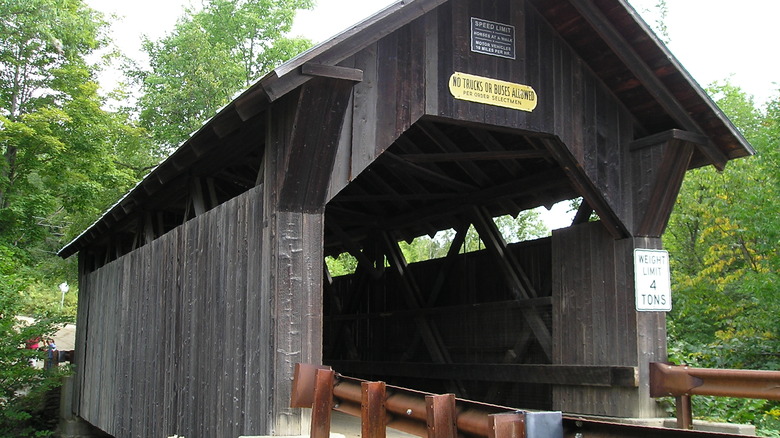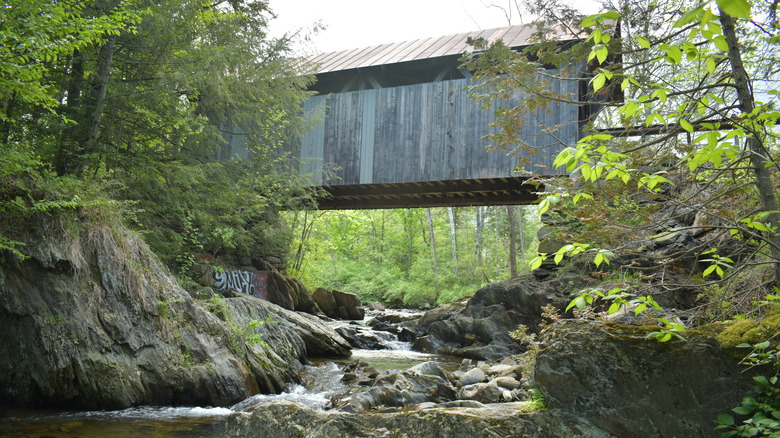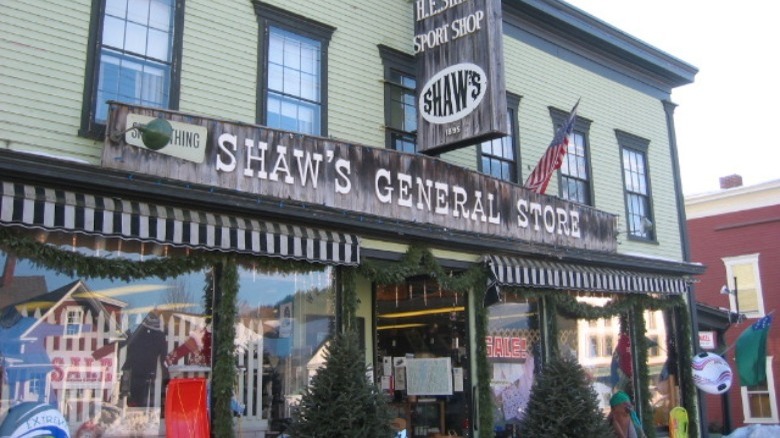This Vermont Bridge Is Said To Be One Of The Most Haunted Places In America
One of the most common and picturesque elements of New England is the covered bridges that can be found scattered throughout the area. There is, however, one particular bridge that is known less for its quaint and charming qualities than for its reputation as a dangerously haunted location. As Vermonter explains, the bridge that is officially called the Gold Brook Covered Bridge or the Stowe Hollow Bridge in the town of Stowe, Vermont, is better known as Emily's Bridge thanks to an enduring legend that has become ingrained in local culture in the past few decades.
As with many local ghost legends, there are a number of variations on the story of the bridge, but they all center on a heartbroken young woman named Emily. According to one version, the young Emily was waiting at the bridge for her boyfriend so they could elope, but when he never showed up because of fear that her parents did not approve of him, she hanged herself from the bridge's rafters.
Alternatively, the Stowe Reporter records versions of the story in which after being left at the altar, Emily speeds off in a carriage (or car) only to accidentally be thrown from the bridge. In yet another version, Emily simply jumped off the bridge in lovelorn despair. The date of Emily's tragic end is said to be anywhere from the 1840s when the bridge was new to the 1940s when a car would have been more likely to be the cause of Emily's demise than a horse-drawn carriage.
Feeling the claws of Emily's ghost
The haunting surrounding "Emily's Bridge" allegedly contains a lot of the common phenomena that you would expect from a place with a ghost: eerie noises emanating from the bridge's tunnel, sightings of Emily herself, orbs of light and other visual phenomena, and a mysterious woman's voice. As Stowe Country Homes explains, however, one of the more unusual occurrences at Emily's Bridge is much more unique to the location. According to legend, cars that pass through the covered bridge find themselves covered with long, claw-like gouges that are believed to be the result of a vengeful Emily herself clawing at any car that doesn't have her lost love in it. Likewise, there are even stories of pedestrians ending up at the business end of Emily's wrathful claws, with scratch marks down their backs as a sign that Emily's anger hasn't decreased over the decades.
The account of a local ghost hunter preserved at Vermonter says that pictures taken at the bridge often develop improperly, with many orbs and wisps of light covering the images. When the ghost hunter tried to ask questions of Emily's ghost, he soon experienced excruciating pain on the back of his neck, a suffocating pressure on the front of his neck, and a roaring sound in his ears that caused him to become exhausted and disoriented. These effects only dissipated once he managed to get breathlessly into his car and drive away.
Debunking the haunting of Stowe
Despite the dramatic quality of such stories and the impactful visual of a car covered in claw marks, the ghost story of Emily's Bridge doesn't have much evidence to support it. As the Stowe Reporter explains, there's no evidence of this story (which apparently happened any time from 1844 until 1949) existing prior to the 1930s, with the 1970s being a much more likely date of origin for the tale. In fact, the Stowe Historical Society has no record of a woman named Emily killing herself on the Gold Brook Covered Bridge at any time, let alone within the broad window of time contained within the popular legends.
Ghost hunters have likewise come up dry in their research through local records. Interestingly, if the version of the story where Emily jumped off the bridge were true, then the legend likely centers around the wrong bridge, as the Gold Brook Covered Bridge isn't very high up. A nearby bridge at the intersection of Gold Brook Road and Gold Brook Circle is much higher. But no Emilys died at that bridge, either.
Many agree that the story was started in the 1970s by a local columnist named Nancy Stead, who made up the legend in order to give some local children a good-natured fright in the wave of popularity of stories of witches and the occult in the wake of the film The Exorcist. According to Vermonter, Stead herself has admitted making up the story with a friend, but the legend persists nevertheless.
An old legend causes modern problems
As Atlas Obscura points out, the fame of Stowe's haunted-covered bridge has spread beyond just ghost hunters and paranormal enthusiasts. Souvenirs for tourists visiting picturesque Stowe boast images of Emily's Bridge, called such by name on the items themselves. All the notoriety of this haunted location has apparently caused trouble for Stowe locals who just want to live their lives. According to a 2013 Stowe Reporter article, people who live near the bridge are greeted with an onslaught of nightly disturbances of the much more human variety than what the ghost stories suggest. Residents reported sounds of partiers loudly enjoying more than a few adult beverages, revving their engines, and even racing their cars through the covered bridge.
The article makes a distinction between late-night revelers and authentic ghost hunters, who residents describe as being typically respectful and quiet unless they get spooked by something. In contrast, one Stowe resident related having to call the police on noisy partiers and street racers every few weeks during the summer. The police chief, on the other hand, reported that they only ever found tourists and ghost hunters out there, never anyone drinking or breaking the law, so maybe it really was a ghost the residents were hearing? At any rate, the complaints from locals led to an ordinance restricting access to the bridge at night in order to minimize bad behavior, but good luck getting a vengeance-mad ghost to follow municipal laws.



